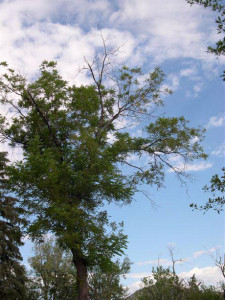
Crown thinning and leaf yellowing associated with thousand cankers disease of walnut (Colorado State University)
A little over one hundred years ago an estimated 4 billion chestnut trees blanketed the eastern hardwood forest of the U.S. Between 1900 and 1908 an accidentally introduced, and most devastating disease, called chestnut blight, was introduced. Forty years later, it was nearly impossible to find a single mature chestnut tree in the eastern U.S.
The chestnut illustrates the rapid changes possible with invasive pests. It may, or may not, foreshadow what is about to happen with another important tree, black walnut, Juglans nigra. One of our most valuable hardwood trees in the eastern U.S. and eastern Texas, this species appears to be highly susceptible to a disease called thousand cankers disease (TCD) of walnut. The disease is spread by an insect, called walnut twig beetle, Pityophthorus juglandis.
The progression of TCD throughout the West seems to be linked to a recent range expansion of this insect. Entomologists and foresters had hoped that the prairies of the Great Plains would serve as a barrier to both walnut twig beetle and the disease. Educational information urging people to avoid carrying walnut firewood eastward from infected zones had been distributed this past year. Unfortunately, about 10 days ago TCD was confirmed for the first time in the heart of the native range of black walnut in Tennessee.
According to Dr. Whitney Cranshaw, Extension Entomologist with Colorado State University and co-describer of TCD, the disease is relatively slow to develop, at least compared to chestnut blight or Dutch elm disease. He estimates that within 30 years after being introduced into a city all black walnuts will be dead. This estimate is based on the disease taking 10 to 20 years to show symptoms after the initial point infestation, and 10 to 15 years for it to progress across a city once the first symptomatic tree is detected.
If you have walnut trees on your property, you might want to familiarize yourself with the symptoms of this disease by visiting the CSU site. The rest of us can remember that it’s not nice to fool with Mother Nature, and sometimes the results can be heart-breaking.